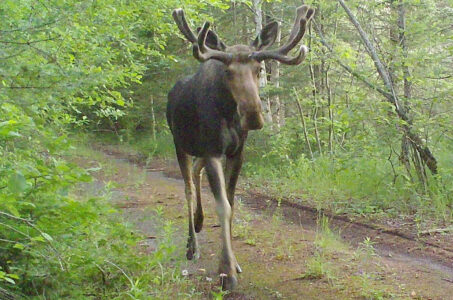Finch visits may be down
Northwoods Notebook

An annual forecast on winter finch movements predicts this winter will not see a major influx, or irruption, of northern species such as this common redpoll, though modest numbers may still turn up at backyard feeders. (Betsy Bloom/Daily News photo)
The Finch Research Network’s annual Winter Finch Forecast is out and predicts this will not be a particular noteworthy year for boreal forest birds to wander south for the winter, though some still could make an appearance, even if passing through.
Tyler Hoar, who took over the winter finch forecast from Ron Pittaway, does stress it primarily is aimed at the Ontario area, eastern Canada and eastern adjacent U.S. states. But it’s not uncommon for many of these birds to overlap into the western Great Lakes area for the winter, so the report can reflect what we might hope to see here.
Hoar predicts this will not be a major “irruption” year — when abnormal numbers of certain bird species venture far outside their normal wintering areas — as was the case last winter.
In 2020-21, evening grosbeaks turned up, well, almost everywhere, a “generational” irruption that saw individuals stray as far south as Florida. A common redpoll popped up at a feeder in Albuquerque, N.M., hoary redpolls — an arctic species — in Cleveland, Ohio.
For this coming winter, Hoar advises that while a number of these species still should be present, they will not be numerous, so will take some hunting to find.
What might make it worth stocking up the backyard feeders is the widespread wildfires and drought to the west both in Canada and the United States.
The cone crop, according to the report, from Lake Superior west is poor to average but along the southern edge eastward is better to bumper.
Drought and wildfires west of Lake Superior also depleted some of the berry crops, which could lead some western species to venture into the upper Midwest searching for food.
Knowing the Upper Peninsula did not have the same dry conditions as seen just to the west of us in Wisconsin and into northern Minnesota, it does set the stage for potentially having some decent winter birds.
Some of the species the report predicts could end up in the area include pine grosbeaks, white-winged and red crossbills and maybe some common and hoary redpolls — though Hoar predicts most will remain north of Lake Superior. Farther west may have better prospects those birds — along with pine siskins.
The report suggests black oil sunflower seeds to birds to backyard feeders, along with nyjer seeds that appeals to the redpolls and siskins.
Evening grosbeaks, too, may have an “echo flight” southward, though not on the scale of last year’s irruption, according to the report.
One of the “non-finch” birds that also can be irruptive in winter, Bohemian waxwings, also may come through the region from the west searching for mountain ash and other berry crops. Watch for them on ornamental crabapple and other trees with small fruit or berries.
Betsy Bloom can be reached at 906-774-2772, ext. 240, or bbloom@ironmountaindailynews.com.




